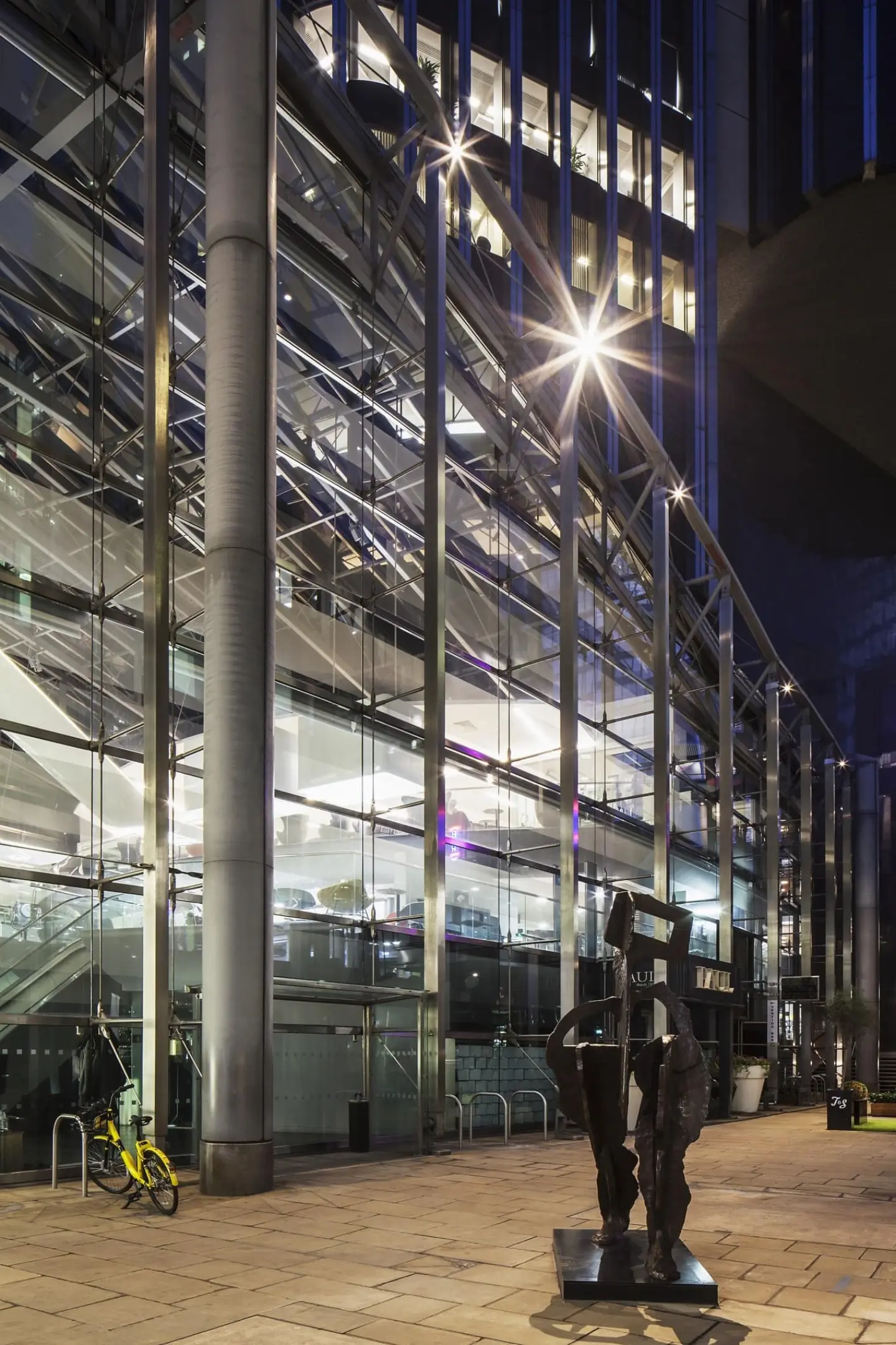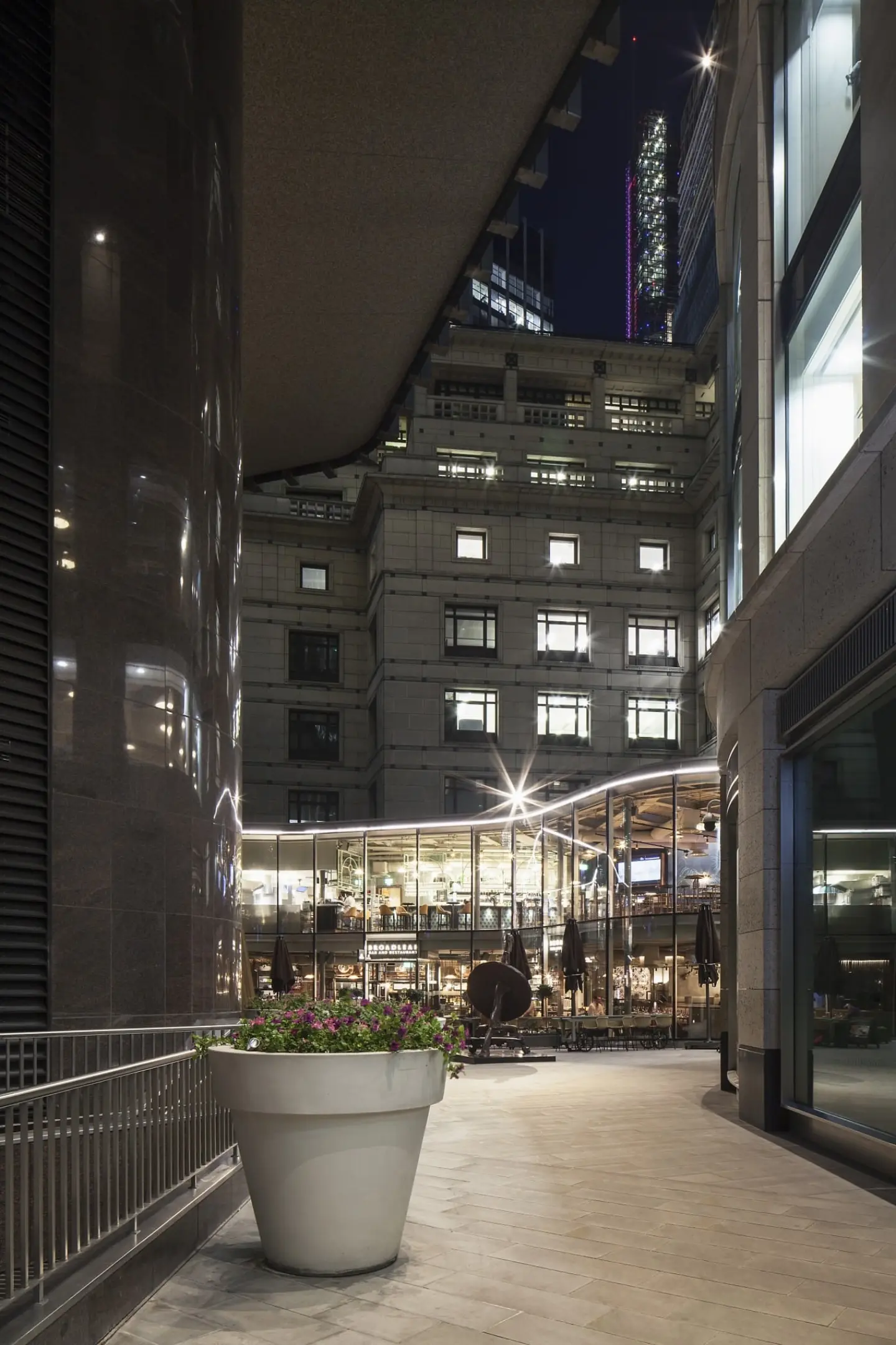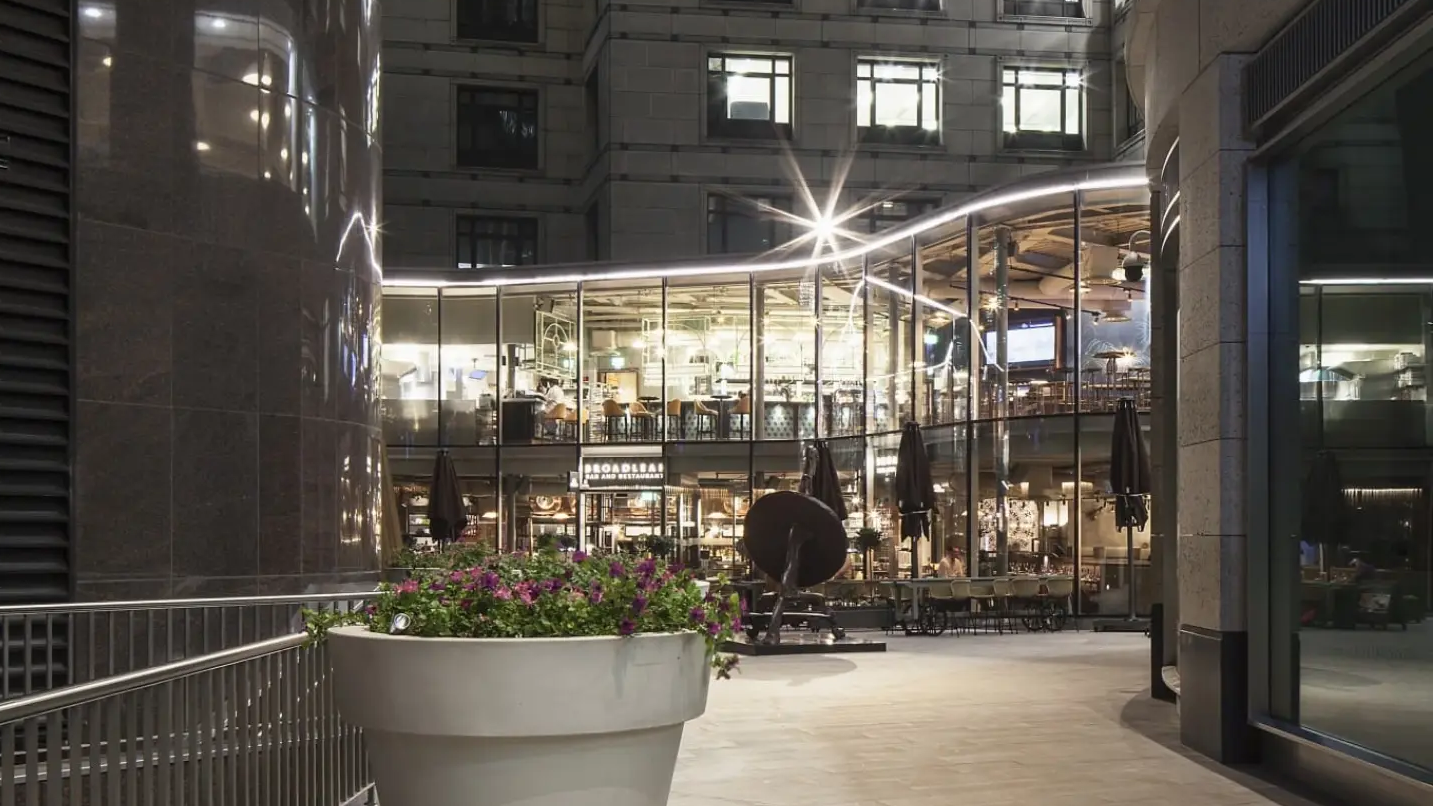

The lighting approach here was to create a slim flexible line of light that could curve around the end of the retail pod

Client
Tower 42 Partnership
Location
Bishopsgate, London
Architect
Hyland Edgar Driver
LAPD carried out the landscape architecture lighting for the newly landscaped areas around Tower 42 and 15 Bishopsgate.
Prior to work commencing, the light levels around the area were predominantly low. Occasional lighting columns produced glare due to their poor optical control.
The design intent was to clear the area of columns and use building mounted lighting wherever possible using a bespoke architectural lighting design. There was also a desire to entice pedestrians through the area, past new retail destinations that populated the site.
A significant issue with the existing lighting, in addition to the columns, was the level of spill light from the small staircases into the base of Tower 42. The first step was to remove these lights and replace them with luminaires that could illuminate the steps to the required standards but ideally contain the light within each low level zone. This created less visual distraction to pedestrians within the new area.
Two solutions drew pedestrians into the area. One part of the solution attracted people from Old Broad Street between Tower 42 and the new retail units. The other created intrigue to passers by on Bishopsgate.
Old Broad Street Entrance
The curved end of the last retail unit finishes on the pavement of Old Broad Street. The lighting approach here was to create a slim flexible line of light that could curve around the end of the retail pod. It would continue on, travelling deep into the landscaped area and around the other side. This created a direct view line of light that was consistent against the varying retail offers along the pods, it assisted in given the architectural pods their own identity whilst drawing people into the area. Hidden spotlights at high level provided a level of functional light to the walkways once the retail units start to close.
Bishopsgate Entrance
The approach from the Bishopsgate entrance was a little more subtle. Spotlights at high level on the 15 Bishopsgate façade provided soft, warm light levels to the passageway with no glare and no visual clutter. The spotlights used an elliptical beam distribution to ensure that there was no spill light on 15 Bishopsgate or the opposite building. As a result all of the light from the luminaire went directly onto the walkway.
This warm light accompanied an illuminated feature bench in the distance, constructed from wood and wrapping around the base of Tower 42. The bench used a mesh behind the wooden rib elements. A detail in the top of the bench allowed the housing of linear LED luminaires. These grazed light down the front of the mesh and between the wooden slats. A warm white light complemented the warmth of the wooden material. The end result was a feature bench that appears welcoming from a distance.
Illuminating the other side of Tower 42 required a quieter approach. A mixture of elliptical and spot beams at high level illuminated pathways, open areas and a sculpture. Existing staircase lighting recessed into the walls close to the treads produced unwanted levels of glare. LED luminaires using significantly improved optics replaced the existing lighting. The resulting soft, even spread created much less spill light upwards and therefore less glare. Furthermore. these reduced energy consumption and the requirement for maintenance.

Client
Tower 42 Partnership
Location
Bishopsgate, London
Architect
Hyland Edgar Driver
LAPD carried out the landscape architecture lighting for the newly landscaped areas around Tower 42 and 15 Bishopsgate.
Prior to work commencing, the light levels around the area were predominantly low. Occasional lighting columns produced glare due to their poor optical control.
The design intent was to clear the area of columns and use building mounted lighting wherever possible using a bespoke architectural lighting design. There was also a desire to entice pedestrians through the area, past new retail destinations that populated the site.
A significant issue with the existing lighting, in addition to the columns, was the level of spill light from the small staircases into the base of Tower 42. The first step was to remove these lights and replace them with luminaires that could illuminate the steps to the required standards but ideally contain the light within each low level zone. This created less visual distraction to pedestrians within the new area.
Two solutions drew pedestrians into the area. One part of the solution attracted people from Old Broad Street between Tower 42 and the new retail units. The other created intrigue to passers by on Bishopsgate.
Old Broad Street Entrance
The curved end of the last retail unit finishes on the pavement of Old Broad Street. The lighting approach here was to create a slim flexible line of light that could curve around the end of the retail pod. It would continue on, travelling deep into the landscaped area and around the other side. This created a direct view line of light that was consistent against the varying retail offers along the pods, it assisted in given the architectural pods their own identity whilst drawing people into the area. Hidden spotlights at high level provided a level of functional light to the walkways once the retail units start to close.
Bishopsgate Entrance
The approach from the Bishopsgate entrance was a little more subtle. Spotlights at high level on the 15 Bishopsgate façade provided soft, warm light levels to the passageway with no glare and no visual clutter. The spotlights used an elliptical beam distribution to ensure that there was no spill light on 15 Bishopsgate or the opposite building. As a result all of the light from the luminaire went directly onto the walkway.
This warm light accompanied an illuminated feature bench in the distance, constructed from wood and wrapping around the base of Tower 42. The bench used a mesh behind the wooden rib elements. A detail in the top of the bench allowed the housing of linear LED luminaires. These grazed light down the front of the mesh and between the wooden slats. A warm white light complemented the warmth of the wooden material. The end result was a feature bench that appears welcoming from a distance.
Illuminating the other side of Tower 42 required a quieter approach. A mixture of elliptical and spot beams at high level illuminated pathways, open areas and a sculpture. Existing staircase lighting recessed into the walls close to the treads produced unwanted levels of glare. LED luminaires using significantly improved optics replaced the existing lighting. The resulting soft, even spread created much less spill light upwards and therefore less glare. Furthermore. these reduced energy consumption and the requirement for maintenance.